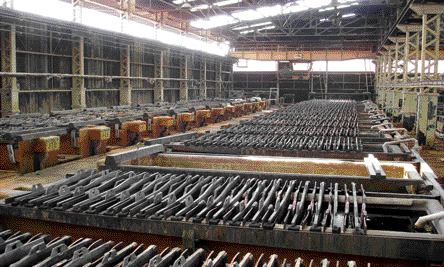A feasibility study on the dormant Kamoto copper mine in Katanga province, Democratic Republic of the Congo (DRC), says a capital infusion of US$427 million can put the mine back into production.
Katanga Mining (KAT-V, KATFF-O), which holds a 17.5% interest in the project and an option to increase that to 75%, commissioned the study, which was led by consulting firm Hatch. Katanga’s interest is held through a 23.3% shareholding in Kinross Forrest, a company originally formed by Kinross Gold (K-T, KGC-N), former Kinross executive Arthur Ditto, and Congolese industrialist George Forrest. Kinross retains an 11.7% shareholding and Ditto is now president of Katanga Mining.
Congolese state mining agency Gnrale des Carrires et des Mines (Gcamines) holds the other 25% of Kamoto. Gcamines also holds a 2% royalty on revenue, less selling expenses and debt redemption, falling to 1.5% after three years. The project is also subject to a 2% royalty due to the DRC.
Hatch concluded the project — which encompasses an underground mine, open pits, a mill and a metallurgical plant near the major mining centre of Kolwezi — could resume production with a new mining fleet, upgrades to the underground pumping and ventilation systems, and refurbishment of the existing mill and plant. The operation could resume production at 122,000 tonnes copper and 6,400 tonnes cobalt annually.
There would be a 4-phase capital program, with the first phase to cost US$176 million and the whole program, US$427 million. About US$150 million of the total would go into refurbishment and later expansion of the metallurgical plant, and about US$80 million into the Kamoto underground mine, including the greater part of the mining-fleet costs. Another US$231 million, beyond the capital cost, would go into sustaining capital over a 20-year period.
Mining could resume from underground as soon as an equipment fleet was delivered. The underground reserve at Kamoto is 45.6 million tonnes grading 3.09% copper and 0.39% cobalt, with another 26.1 million tonnes grading 3.96% copper and 0.47% cobalt in resources, including some in pillars that would only be mined as remnants near the end of the mine’s life. Most of the underground ore is sulphide material.
The mine used room-and-pillar stoping, but some of the deposit would be mined by long-hole stoping under the current scenario. Underground costs are estimated at US$9.36 per tonne of ore.
A ground collapse in 1990 sterilized about 15 million tonnes of resources, and Gcamines’ subsequent capital and cash-flow troubles put an end to production from Kamoto.
Four open pits — Musonoie-T17 West, Mashamba East and West, and Dikuluwe — would be contract-mined to provide oxide ore. The four pits have reserves of 47.6 million tonnes grading 3.2% copper and 0.26% cobalt. Another 46.5 million tonnes, grading 3.13% copper and 0.37% cobalt, are classed as measured and indicated resources. Hatch estimated open-pit mining costs at US$11.24 per tonne of ore.
Plant expansions
The Kamoto concentrator plant has remained in partial production under Gcamines and would require only maintenance and refurbishment. Hatch’s study proposed an expansion in the third phase of production, at year 16 of the 20-year study period, when more flotation cells would be added.
The Luilu metallurgical plant, comprising a set of roasters, a leaching circuit and electrowinning circuits for copper and cobalt, has not been in operation. Hatch proposed adding two new roasters and a new filtering system, and general refurbishment. The plant also has an anode-casting shop that was built, but never operated.
Total metallurgical recoveries (mill and plant) have been estimated at 81% of copper and 44% of cobalt from sulphide ore, 68% to 70% of copper and 30% of cobalt from oxide ore, and 63% of copper and 12% of cobalt from dolomitic ore. Hatch estimated milling costs at US$5.26 per tonne of ore and metallurgical plant costs at US$10.51.
The total operating costs ring in at US$469 per tonne (US21 per lb.) of copper produced, after credits for cobalt. At assumed prices of US$2,425 per tonne for copper and US$10 per lb. for cobalt, the project has a net present value of US$649 million at a discount rate of 6%. Its internal rate of return is 25.5%.
Katanga Mining has arranged an underwritten private placement with a syndicate of six investment houses led by GMP Securities, under which Katanga will issue 14 million subscription receipts at $7.25 apiece. GMP has an option to take another 7 million units. The deal will gross $101.5 million, or $152 million, if GMP’s option is fully exercised. The receipt units convert into shares, without any attached warrants, once Katanga has three things: shareholder and regulatory approval for its takeover of Kinross Forrest, regulatory approval for a share issue, and a compliant technical report on the Kamoto project.
In other Copperbelt news, Simberi Gold (SAU-V, SIBIF-O) has commissioned an update to an earlier feasibility study on the Kakanda project, near Likasi. The 1997 feasibility study, for International Panorama Resource, the predecessor of Kakanda Development (KDC-V, KDCOF-O), considered reprocessing tailings at the Kambove tailings pond and some mining from the Kakanda open pit. Part of the study will be to update a pre-National Instrument 43-101 resource figure of 18.4 million tonnes tailings, grading 1.22% copper and 0.15% cobalt, and 11.3 million tonnes in the Kakanda pit, grading 3.14% copper and 0.19% cobalt.
Simberi owns 67% of PTM Minerals, previously held by Kakanda Development, and has an agreement to buy the other third of the company. PTM has a joint-venture agreement with Gcamines to take over 51% of the Kakanda project by providing a feasibility study.


Be the first to comment on "Kamoto copper can resume production: study (April 24, 2006)"